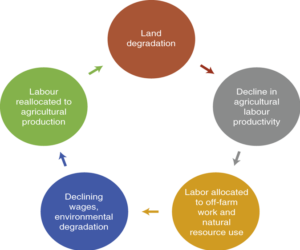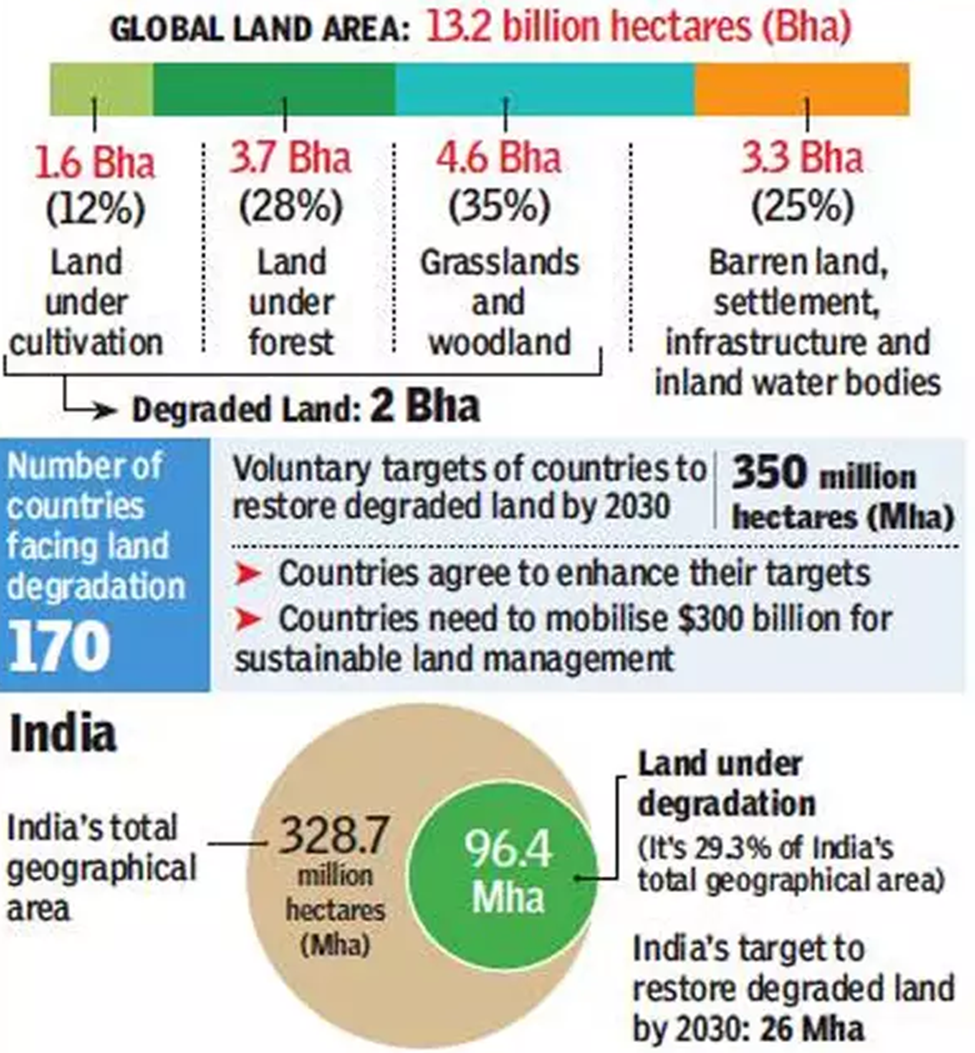AN EXPANSIVE LAND MANAGEMENT POLICY IS OVERDUE
Relevance: GS 3 – Land reforms in India
Why in the News?
- Land plays a central role in human activities, offering ecological, economic, social, and cultural services. However, the multi-dimensional importance of land is frequently disregarded in land management practices.
- This oversight contributes to increased pressure on land, leading to degradation and environmental decline.
- There is an urgent need for a comprehensive land management policy.
- Thus, establishing a multi-stakeholder platform at district and sub-district levels is crucial.
Economic Impact of Land Degradation:
- Globally, annual losses of ecosystem services due to land degradation are estimated at $6 trillion.
International Efforts and Discussions
- The United Nations Convention to Combat Desertification (COP14) in 2019 addressed the issue of land degradation and emphasized achieving land degradation neutrality.
- The Intergovernmental Panel on Climate Change’s special report on ‘Climate Change and Land’ (2019) advocated for country-level stocktaking of land management practices.
- It recommended both near- and long-term actions focusing on land management options that minimize competition for land while maximizing co-benefits and preserving ecosystem services.
Urgency in Addressing Land Concerns:
- The Food and Agriculture Organization’s report titled ‘State of the World’s Land and Water Resources for Food and Agriculture: The System at Breaking Point’ (2021) underscored the need for urgent action in caring for the long-term future of land, soil, and water.
- It highlighted the neglected area of public policy and human welfare concerning the preservation of land resources.
India’s Land Management Challenges
India, with only 2.4% of the world’s geographical area but over 17% of the global population, faces numerous land management hurdles.
- Approximately 55% of India’s total geographical area is arable land, while forests cover around 22%, leaving the remainder comprising desert, mountains, etc.
- About 30% of India’s total geographical area is classified as degraded land.
- Access to agricultural land remains a significant livelihood issue for a large portion of the population reliant on agriculture.
- Development goals, population growth, infrastructure demands, rapid urbanization, and socio-cultural factors are exerting unprecedented pressure on land resources.
- This pressure leads to heightened competition among farmers, inter-sectoral conflicts, escalating land prices, and evolving land rights issues.
- Across the country, natural areas are diminishing, resulting in the loss of ecological functions and biodiversity.
- The decline in natural ecosystems adversely affects livelihood opportunities and weakens their resilience against disasters like floods, droughts, temperature rise, and pollution.
- Climate change introduces additional challenges, exacerbating existing land management issues.
Current Land Management Situation in India
- Land management practices in India are currently sectoral, with each department following its own approach.
- Land management falls under the jurisdiction of State governments.
- Most land in India is privately owned, and land-use decisions are typically made by the owners.
- Administrative complexity arises from this sectoral approach and decentralized decision-making.
- Challenges include knowledge gaps, short-term planning biases, fragmented approaches, lack of preparedness for unforeseen events, and regulatory barriers.
Proposed Solutions for these challenges
- Establishing a multi-stakeholder platform at district and sub-district levels is essential.
- This platform would bring together farmers, land managers, policymakers, civil society organizations, business leaders, and investors.
- Article 243ZD (1) of the Constitution allows for district planning committees to consolidate plans from panchayats and municipalities.
- Activating these committees can facilitate the preparation of a comprehensive land management plan covering agricultural and non-agricultural sectors.
- Adopting a Landscape Approach: A landscape approach would offer a holistic perspective to assess land potential and determine appropriate land uses.
- This approach aids in evaluation, negotiation, trade-offs, and decision-making.
- Implementing a climate-smart landscape approach would align with climate objectives, increase agricultural production, improve local livelihoods, and conserve biodiversity.
- Integrated Landscape Management
- Science emphasizes the significance of viewing land as a system and promoting integrated landscape management.
- While there is practical experience supporting this approach, systematic institutional support is lacking.
International Recognition and Guidance
- The European Landscape Convention underscores that landscape contributes to individual and social well-being.
- The K. Parliamentary Office of Science and Technology highlighted in Brief 42 (‘Sustainable land management: managing land better for environmental benefits’) the critical role of land management in addressing climate change, ensuring food security, and combating the biodiversity crisis.
- It cautioned against the inadequacy of existing government policies and targets in addressing the complexities of land management, farming, and environmental preservation.
Potential for Parliamentary Action in India
- India’s parliamentarians could initiate discussions on the emerging challenges of integrated land management practices.
- Their involvement can aid in devising appropriate policies for long-term sustainability, engaging all stakeholders across horizontal and vertical scales.
Mains question
Discuss the significance of integrated landscape management in achieving sustainability. Examine international frameworks and suggest measures for effective implementation in India. (Word limit: 250)





